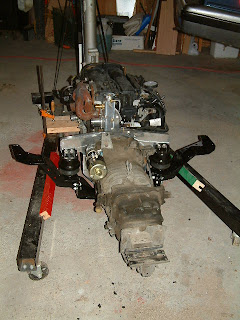New boots and bushing, ready for the shift lever on the left end. I'm going to put this in last, since there's a chance the new shift lever will arrive next week, and having the shift linkage uninstalled won't prevent us from starting the engine and checking it out.
Next, we put in a new fuel line for the pump-to-engine run. I bought enough fuel line to replace both the feed and return sides, but the return side is connected to the fuel tank on the top of the tank, which can only be reached if the tank is dropped. We know there's a vapor leak in the rat's nest of tubing on the top of the tank, but it's not in the return line, and since it operates at a lower pressure than the feed line, I'm going to wait until spring to renew it. I will need to drain and lower the gas tank to fix the leak and replace the line, and it's better to do this outside (in a blowing wind), since it will involve spilling gasoline.
Here's a shot of the attachment of the return line to the new fuel pressure regulator, which is the item visible in the center - the hose attachment is at the bottom, feeding through the corrugated protector. I had to use a temporary clamp, since the kit came with only two fuel hose clamps, which I used on the feed line:
Attached to the outlet of the fuel filter. The original installation used lots of Oetiker clamps, which are really best for this application. I may spring for an Oetiker kit someday and re-do these.
Here's the feed line running up the back of the firewall. The original line was clamped to the brake distribution block with a special hose clamp. It happened that I had a perfectly sized new hose clamp that worked with the new hose and the old bolt:
Routing the new hose over the top of the transmission bay and through the old hole that housed the old line, I added extra abrasion protection, tied the line with zip ties to the back of the engine bay, then trimmed and attached it to the new fuel rail input. Tomorrow, I'll start installing the new wiring harness, and if I can get a couple of additional fuel hose clamps, finish the return line.

















